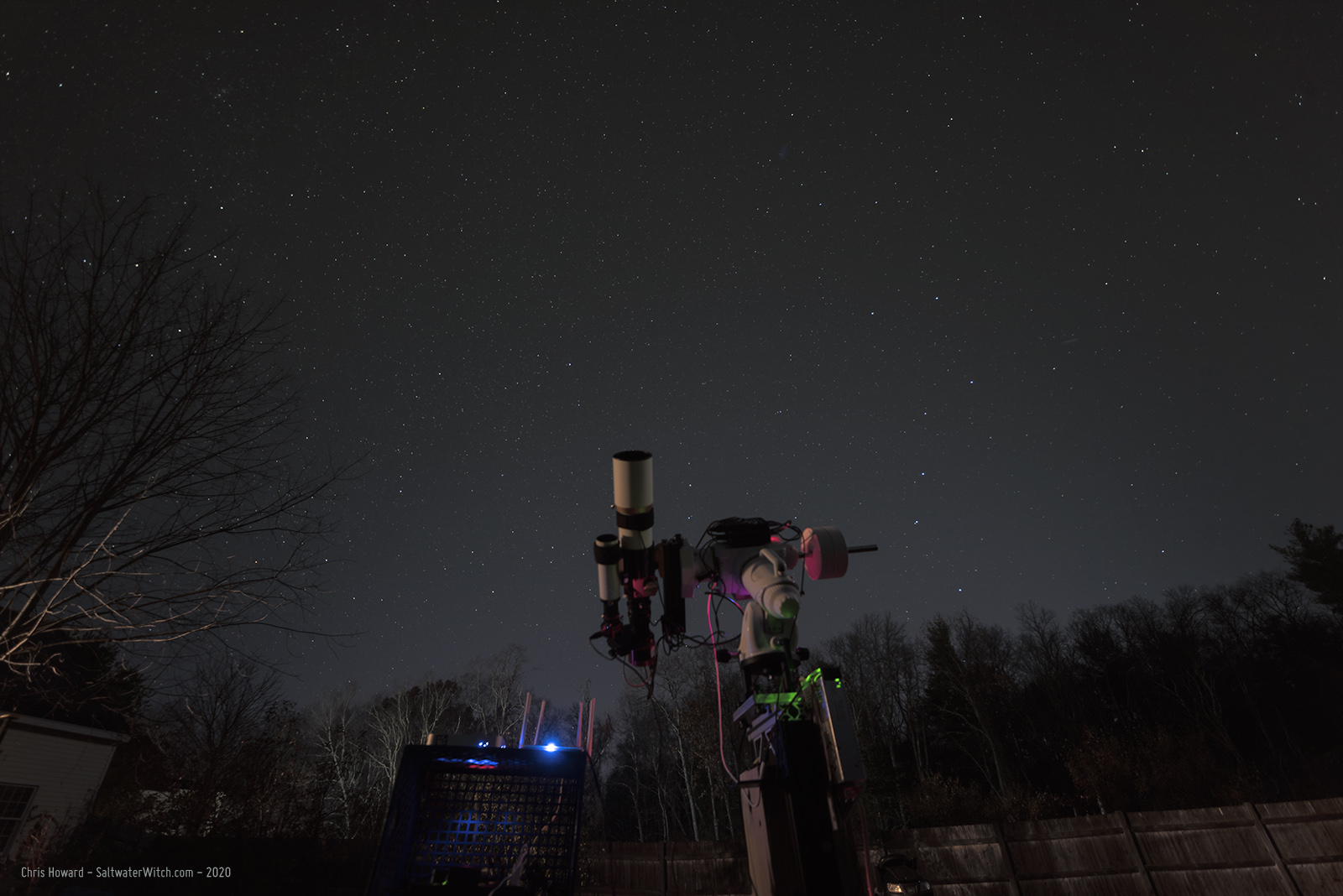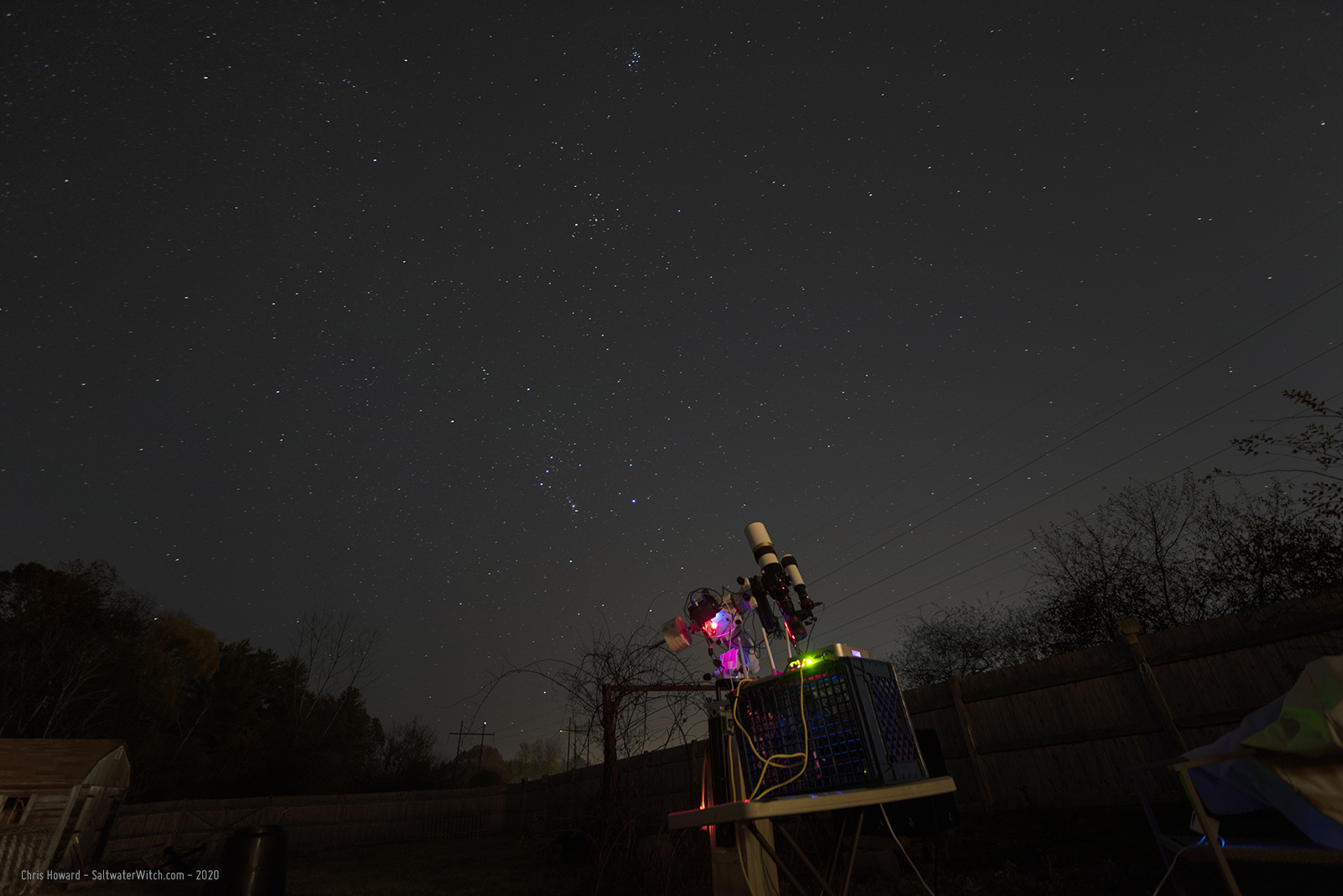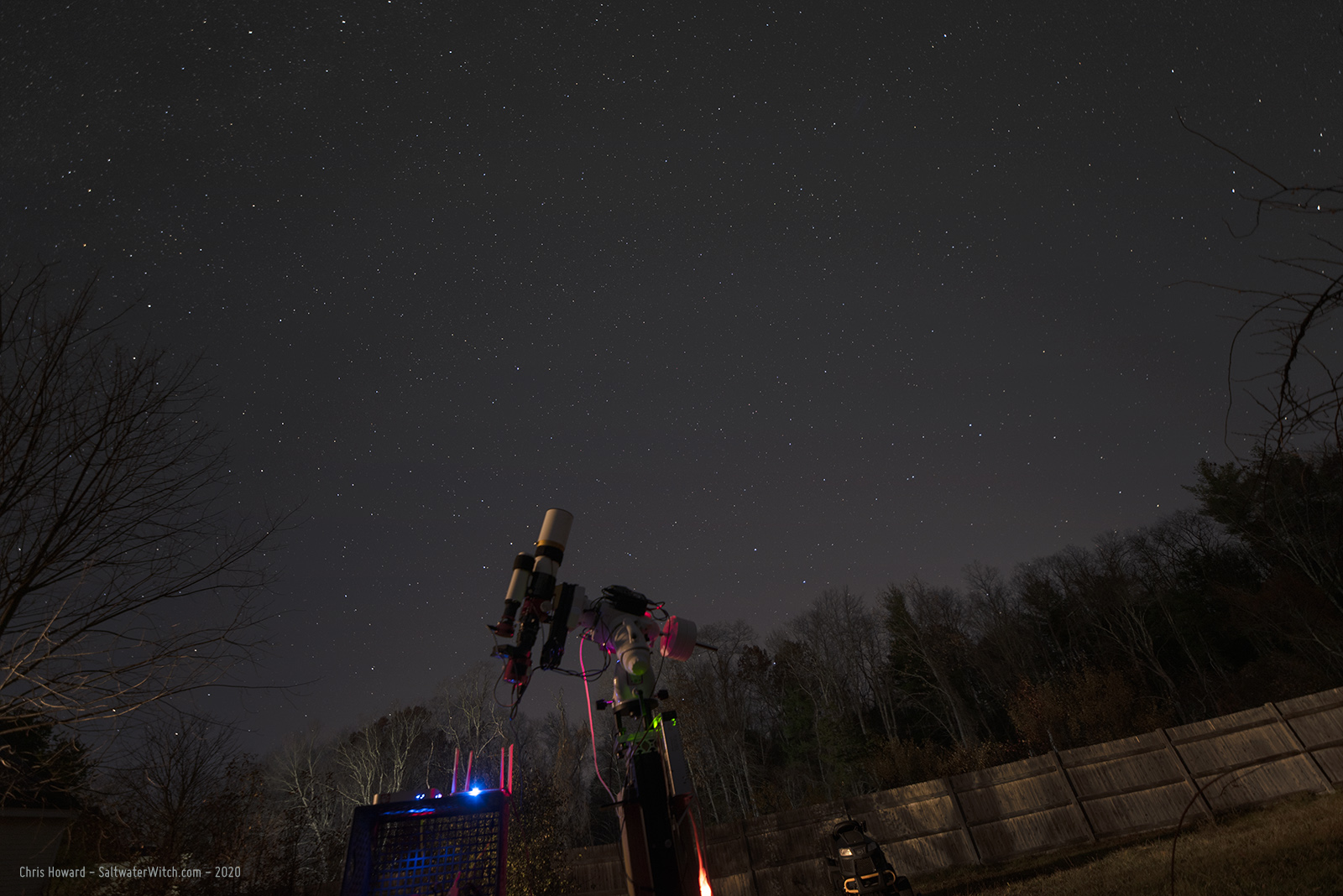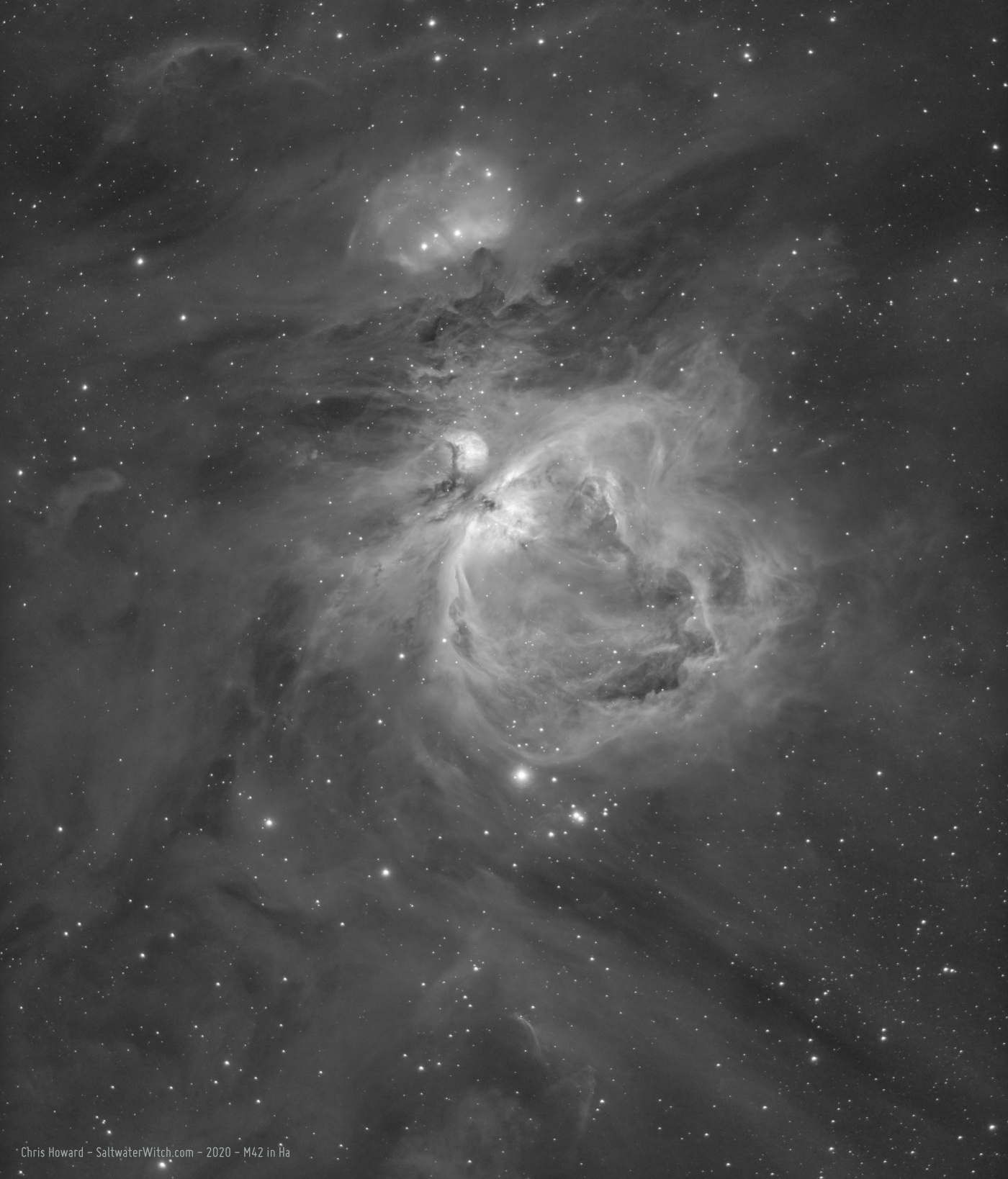M81 and M82
After the earth rotates Orion and Monoceros out of view in the south, I'm only left with a few nebulae. There are a bunch of galaxies though... But with the scope I'm using for large deep sky objects (William Optics GT81 with 392mm focal length), most are too small. M81 (Bode's Galaxy) and M82 (Cigar Galaxy) however, are just large enough to capture. This shot is made up of 30 x 60-second subs in Hydrogen-alpha, Green, and Blue filters that I've mapped to RGB. With the Ha filter you lose some of that broadband Red light, but the trade-off (better IMO) is you capture any large H2 regions in the galaxies. Those are the red and pink chunky bits in Bode's Galaxy and a lot more of that "starburst" core of the Cigar Galaxy—so, basically I'm capturing nebulae in someone else's galaxy, almost 12 million lightyears away from us. Cool. Both of these Messier Objects are in the Constellation Ursa Major (Big Dipper). Gear notes: SkyWatcher EQ6-R Pro mount, William Optics GT81 Apochromatic Refractor 392mm at f/4.7, ZWO ASI1600MM-Pro monochrome camera, Astronomik 6nm filters, Moonlite focuser, Raspberry Pi 4 4GB / 128GB running INDI/KStars/Ekos

Posted November 17, 2020
Rosette Nebula and Surrounding Region
From the imaging run last night. The Rosette Nebula (NGC 2237) in the Constellation Monoceros is another deep sky object I typically capture every year--at least once! Trailing Orion across the sky, it's over a 100 light-years across and about 5000 lightyears away from us. 50 x 240 second sub-exposures in Ha. Gear notes: SkyWatcher EQ6-R Pro mount, William Optics GT81 Apochromatic Refractor 392mm at f/4.7, ZWO ASI1600MM-Pro monochrome camera, Astronomik 6nm filters, Moonlite focuser, Raspberry Pi 4 4GB / 128GB running INDI/KStars/Ekos

Rosette Nebula in the Constellation Monoceros (detail). You're looking at about 360 trillion miles of globules and globulettes—all those dark cloudy bits, running from the bottom middle of this frame to the top right. This is a detail view of my last Hydrogen-alpha image of NGC 2237 where interstellar gas and dust around one side of the Rosette Nebula have condensed into strings of dark cloudlets that block the emission from the core group of stars lighting up the broader background. Several of the stars that make up the cluster NGC 2244 are massive super-hot O-type stars, and these produce the stellar winds and intense radiation that have shaped the Rosette Nebula. To give you a sense of the scale here, pick any of the branches in those dark cloudy structures, or even most of the loose globules of condensing hydrogen. Our entire solar system can easily fit within the width of one of these. And I'm not talking about the orbit of Pluto; I'm using the Oort Cloud as the defining boundary, which would make the diameter of our solar system roughly 1.5 lightyears. In other words you can fit about 240 of our solar systems, lined up one after the other, in the same space as this chain of dark clouds. William Optics GT81 @f/4.7 Astronomik 6nm Ha filter, ZWO ASI1600MM-Pro mono camera.

Posted November 15, 2020
California Nebula in Ha + SII
Tuesday night I captured 50 x 4-minute sub-exposures in Hydrogen-alpha for NGC 1499 (California Nebula) and last night I captured 60 x 240 second exposures in Sulfur 2 (SII), combining them here into a color image, with Ha in red, SII in blue, and each shared equally across the green channel of an RGB image. There just isn't any OIII (Oxygen) in the mix for this massive emission nebula in the Constellation Perseus. Gear notes: SkyWatcher EQ6-R Pro mount, William Optics GT81 Apochromatic Refractor 392mm at f/4.7, ZWO ASI1600MM-Pro monochrome camera, Astronomik 6nm filters, Raspberry Pi 4 4GB / 128GB running INDI/KStars/Ekos

Posted November 15, 2020
A Night in the Life of an Astrophotographer
Posted November 10, 2020
Astro Session November 11, 2020
Wow, we actually have a pretty decent view of the universe from our backyard. Notes: Nikon D750, Irix 15mm f/2.4, 30-second exposures. That's Ursa Major, the Big Dipper, to the right of the scope, that upside down W in the tree branches is Cassiopeia, and that bright star between them, a little to the left of where the scope is pointing, is Polaris, the North Star.



Posted November 10, 2020
The Orion Nebula in Hydrogen-alpha
I have to capture M42, M43, NGC 1977, the Orion, De Mairan's, and Running Man Nebulae at least once a year, and now through December is when the Constellation is high in the sky and still early enough be awake--I captured most of the 52 subs that went into this shot between 11:30 and 2am. This is just one filter's worth. I have to go back and either take OIII and SII or Blue and Green, using this Ha capture for the Red channel in RGB.
Imaging session notes: 52 x 240 second subs + 50 x 10 second subs for the Trapezium, stacked in DSS, processed in PS 2021. SkyWatcher EQ6-R Pro mount, William Optics GT81 Apochromatic Refractor 392mm at f/4.7, ZWO ASI1600MM-Pro monochrome camera, Astronomik 6nm Ha filter, Controller: Raspberry Pi 4 4GB / 128GB running INDI/KStars/Ekos.

Posted November 10, 2020
California Nebula in Hydrogen-alpha
The California Nebula (NGC 1499) in the Constellation Perseus is relatively close to us, about 1000 lightyears away in the Orion Arm of our galaxy (Milky Way), and it's roughly a 100 lightyears in length, so what you see here, top to bottom, is about 600 trillion miles of ionized hydrogen. NGC 1499 is a good-sized emission nebula, about 2.5° in length from our view on Earth. To put that into perspective, a full moon is 1/2°, so the California Nebula is about 5 full moons long in the sky.
Imaging session notes: 50 x 240 second subs, stacked in DSS, processed in PS 2021. SkyWatcher EQ6-R Pro mount, William Optics GT81 Apochromatic Refractor 392mm at f/4.7, ZWO ASI1600MM-Pro monochrome camera, Astronomik 6nm Ha filter, Controller: Raspberry Pi 4 4GB / 128GB running INDI/KStars/Ekos.

Posted November 10, 2020
Try out the new pier with some imaging
The weather has not been cooperative but I have set up the SkyWatcher EQ6-R Pro on the new backyard pier, along with the William Optics GT81 and my narrowband imaging train. I'm using the latest (v1.54) Stellarmate for these tests, but not in Stellarmate mode (not using the app). I'm remoting into the machine, running on a Raspberry Pi 4 4GB board with 128GB, and just running KStars/Ekos there. I used the QHY Polemaster on the Mate to polar align, and that was easy. My one imaging test so far with NGC 281 (Sh2-184) the Pacman Nebula in Hydrogen-alpha worked well enough with 7 240-second Ha subs stacked in DSS and processed in Photoshop 2021. No calibration frames. There wasn't time before the clouds drifted in. My next test is to use SharpCap Pro's Polar Alignment functions, and see where that gets me.
Some shots from the the night of November 7:



